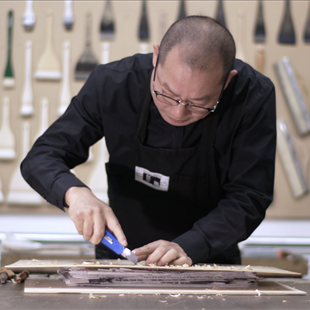Wang Huaxiang: Hi, everyone! I’m Wang Huaxiang. Let me introduce myself first. Here are the sketches I drew when I was a college student. At that time, I particularly admired Michelangelo, Rubens and Dürer of the Renaissance. Actually the sketches didn’t go with the mainstream of the Central Academy of Fine Arts (CAFA), where the traditional Soviet Style was dominant. They, as you can see, combine lines and surfaces, and use structure to emphasize form and space, as well as light and shade. The sketches still touch me today, while they might not be satisfying at the time, when I sketched them with no hope to reach my goal. But what was the standard? I didn’t know either. There was only one thing I knew, that is the great masters as my models as well as my goal to strive for.

Wang Huaxiang, "The Male Nude", 78X55CM,1986
Here’s the cover of the well-known book named Take the Wrong and Make the Best of It. As you can see, it’s distorted, though created with a very delicate and classic technique. The focus of the sketch is not full-factor but local and very detailed. We can analyze it from the distance of the sketcher, which is a close and super-close view. From then on, all the sketches, including the academic ones, have basically adopted the system of a medium-distance view, that is, to observe an object or a model in a size two or three times bigger than the actual size, so you can get the whole observation, including its proportion and the hue in order to depict the whole of it on the paper. The close view, however, is quite different, which requires the sketcher to come very close to depict the details of the model. If I step back far away and take a look at the sketch, it seems to not overlap with the exact object, but another one. In that case, we start to sketch and create instead of completely representing an object.
The book consisting of the sketches, as you know, is named Take the Wrong and Make the Best of It. Why not Distorted Sketches or something else? Why is the “wrong” emphasized but not corrected? It’s actually based on my judgement of art history, especially on the period from the Renaissance to the time of Modernism, when most painters, although regarding realism as the target and featuring the painting of classical paintings, didn’t reflect the objective of reality. It was thought that the function of the painting was to keep real records, so when cameras appeared, many people over the following hundred years believed that cameras and photography replaced paintings, due to people’s relatively rigid judgment of art history. It was this understanding that led them to think that these tools and new technologies for recording have replaced artists who “keep recording”.
What on earth is the vitality of painting? Why do paintings still exist as many people, in the last one hundred years, in both the West and China, in both the theoretical circles and the painters as well as practitioners declared many times that painting has died. Why? It comes to the topic of my speech today “The Vertical Height of Art.” In other words, if there’s only one new innovation in art, then what’s “new”? It’s opposite to old, from less to more. For example, the traditional artistic style, technology and language are less and relatively simple, while in the era of the modern art, that is since the end of the 19th century, art has been enriched to cover a wider scope, featuring its horizontal development. Therefore, what’s new is an era, with one of the mainstreams as well as cultural phenomena in the past one hundred years.
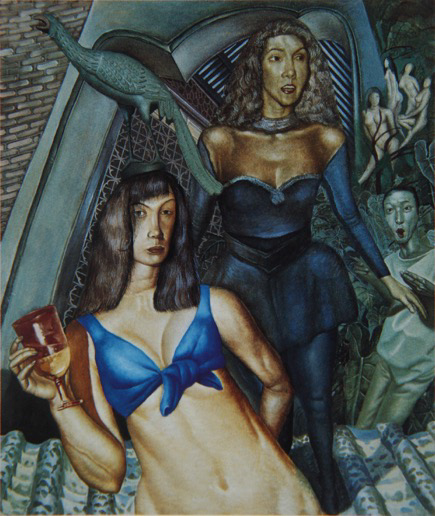
Wang Huaxiang, "Phoenix", Oil on Canvas, 54x45.5CM, 1994
Today, unbalanced information is already impossible in any place in China, especially in the important large universities in the biggest and most developed cities. That is, the information is already popularized and planarized, so being new is no longer a terrible or at least the most serious problem. What’s terrible, then? A case in point was Take the Wrong and Make the Best of It, as an effort to stagger from realism to its opposite. At that time, I tried to take realism as representative art and traditional art as an imaginary enemy and opponent for exploration, which would tend to threaten traditional art. I was therefore put under great pressure: while winning the support from a lot of young people, I was also opposed by a lot of students. So over the last two decades it was a very tough time for me with the conflict between what’s “new” and “old”.
But it’s not a problem today—the “new” or innovation is nothing to be resisted, but instead, at the level of ethics, advocated on a national level. So it’s not a problem any longer. We have gained diversification, different from the simplification in the past. Today, it’s not easy to find pure realism in CAFA, even in traditional schools such as the school of plastic arts, which has been divided into several faculties and departments, each with very few practitioners of realism. In the department of oil painting as the center of realism, we can see there’s only a small proportion of realism among both teachers and students.
Then what about the richness? What’s richness today all about? It is already beyond professions and majors as someone from the department of oil painting may be making installations or photographing; one from the department of printmaking may be making installations, photographing or designing. Thus, we should think in the reverse —what do we lack? During the past one or two decades, when we saw some publications in magazines of other countries or regions, such as those in Japan, Lion Art amongst others from Taiwan Province, something modernist, or World Art magazine introducing foreign schools, there would be corresponding imitators and imitators in China. At that time, when something novel was meant to be something different in our education and our art industry. So in those years in China, the art industry had the same situation as the business circle with few original creations. Generally, we imitated others’ ready-made patterns and off-the-shelf technologies, and then labeled them as our own. So China could only be regarded as a manufacturing power, instead of a design power nor an innovative power. This was true in both fine arts and the business circles over the past few decades.
But China has gradually come to the forefront of the world, after we have learnt a lot from other countries in diversification and general knowledge, skills and ideas. Till then, a zeal for independent thinking will be roused, from the country to the individual, and in various industries. How do we realize the independent thinking and whether we should create some Chinese symbols? Fortunately, some famous Chinese artists have gained an international reputation, which was a strategy and a very successful one. But we came to a higher level, a bottleneck then, as we were always waiting for the West to take action, to assign “homework” for us to finish. As for the right to judge, and how to criticize the art, we actually had no idea because we didn’t have the right of speech. Twenty years ago, I said that “If China was not strong enough, we would have no right of speech and Chinese artists would seem to be rats running on an endless treadmill, up and down. We could never go away from the route designed by others.”
And today, how can diversify from the route and the dead end? The world seems to be stagnant—the treadmill stays still. Take ready-made art as an example. When did the art of ready-made begin? It could be traced back to the early years of Picasso, who tore a bike down into a frame and regarded it as an ox head. It was something pictographic. At that time, an installation still represented an animal or a figure in a pictographic way, the same way we see an installation or sculpture in the world today: we see some machine parts as a house, a human body, or a tiger, right? Duchamp took the urinal directly as a work of art, which was actually made by someone else, but he signed his name on it. This is so called conceptual art, lasting for over a hundred years since 1917. In fact, contemporary art today could be said to start stagnating. Then how to continue with it? After all, the profession has to survive. Sometimes it turns to philosophy, sometimes to sociology, sometimes to religion, sometimes to anthropology, and today to biology or other natural sciences. Why? Because art has been stagnant, and it doesn’t move on very much. I’ve been thinking about this question since the publication of Take the Wrong and Make the Best of It, when I was an opponent against traditions. Then I turned to performance art, just like what I created in 2000 on the turret of the Red Gate Gallery, where I covered my head and wrapped up the heads of all participants and volunteers with clothes. Some read the newspaper, some rode bikes, some fell in love, though all of them were still moving, and studying every day, without direction, their eyes and heads were covered. This was my first work combining Chinese and western elements in the 1990s.
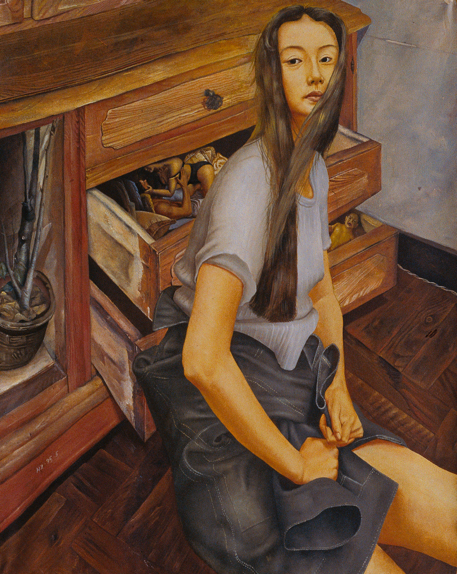
Wang Huaxiang, "An Open Drawer", Oil on Canvas, 100x80CM, 1995
Sometimes it is painful to be too far ahead of one’s time. At that time, the Chinese art circles didn’t accept it, though my paintings sold well in Europe and the U.S. It’s an open drawer, as an adolescent girl’s drawer is her privacy. This is a painting album, in which one part of a page is a classic work while the other is my painting. Then you know, a famous painter has been painting this, because he saw this work of mine, a work I adapted from Dürer—“Man and Serpent”. This is a larger acrylic work created later. Unlike all the other painters, I later became a supporter and a defender of the art traditions. Thus there was a barrier between me and the so-called contemporary fine arts industry. Then I became a traitor to the traditional artists. I have been, therefore, used to acting on my own. If an individual was not valued by their art, we wouldn’t go far, or become thinkers or unique artists, because we may lose the ability to think when chasing the tendency. In spite of my background in printmaking, I have painted for decades oil paintings on whose techniques I spent at least half of my energy. Then many people believe that techniques are basic, with which you can make expressions. It’s just like a person who has learned how to play the violin always plays the ready-written music by others; a sports athlete who has learnt the basic skills can play basketball, football, etc. But this is not the truth.
All the work we are engaged in is technical. In some way, whether the techniques can support our thoughts and convey our emotions is actually restricted by the techniques themselves. To some extent, in the art world of the current era, we exaggerate peoples’ personality and creativity while ignoring the techniques, just like the people in the past, who, for quite a long time, exaggerated the power of ideology, and until the end of WWⅡ, especially the cold war, began to realize that technology was the core and decisive force of human beings. The decline and recession of a country, and the failure of a person are all directly related to technology or techniques. China used to be so developed economically and culturally, but we lagged behind in the years of the industrial revolution, including in printmaking, which was relevant to our profession. China first invented printmaking and retained the leading role in wood engraving, which was then spread to and surpassed by Europe. Later Europe discovered the copper plate, a material with a better modelling capacity than wood, and China fell behind. Later, printing technology continued to develop and until today China only now gets the opportunity to achieve a balance with the world. What gives us the opportunity? It’s the Internet.
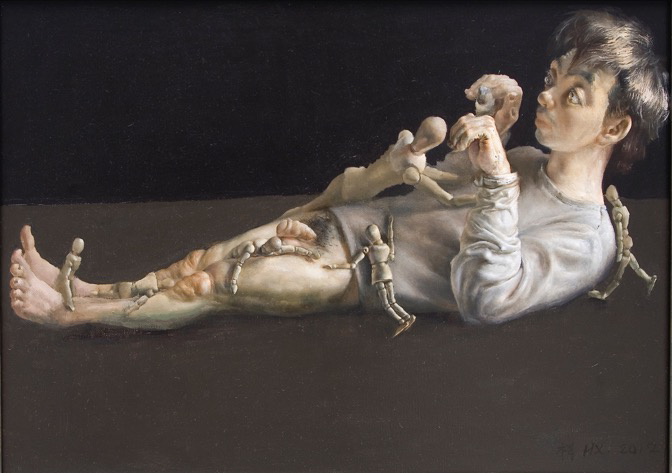
Wang Huaxiang, "Not Fiction", Oil on Canvas, 50x70CM, 2012
In fact, our previous industries were far behind other countries. But in this age of information, China has caught up with them. Therefore, technology is so important that it can save people, a group and even a country. There’s no exception in painting. I’m still thinking about its development. How could painting develop? We have touched upon children’s painting, folk art, the art of African natives, that of the Indian (Native American) style as well as the Oceanian art. We have also studied Chinese folk fine arts, such as the embroidery and masks from Guizhou Province, but where should we go next? Let’s come back to our topic of today. Our scope has become wider, featuring innovation. I think the feature of new innovation is something good that can prevent our minds from a breakdown and overcome our inertia, but that is popularized enough to be a concept and product which could cater to the mass consumption. Innovation in agriculture, for example, is all about making crops more productive. Why is that? Because it has to feed more people. Does “new” equate to “good”? Take our clothes today as an example. We have all kinds of famous brands, which can be copied to create thousands of articles of clothing. Traditional tailors provided a tailored service, didn’t they? To make an article of clothing, they had to measure your height, your waist and so on. Every part of the clothes had to be tailored for you. And a pair of shoes could also be specially moulded for you. Today, however, mass production is prevailing. Why is that? It needs to meet the consumption of more people, which logically tells us that it’s not good, because it has no vertical height. It only has a horizontal width. This kind of thing has a very short and weak life and can survive for only a very short time.
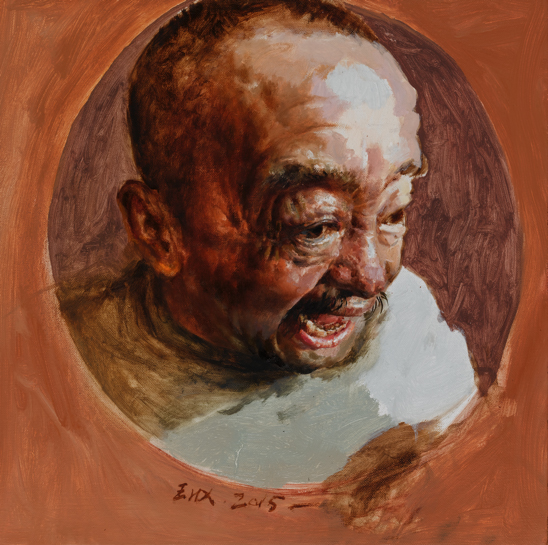
Wang Huaxiang, "You are contemporary. Your whole family is contemporary."
Oil on Canvas, 50X50CM, 2015
Take the clothes for four seasons as an example. When the clothes of 2018 style become cheaper, those of 2017 style would be recycled or discarded, then what about those of 2019 and 2020? So you see, the commercially “new” shortens the replacement rate and length of life. It’s the same with art. An exhibition must have a new theme and be different from the previous ones, with new concepts and new concerns. So what do people leave in such an effort? In fact, for the majority, nothing has been left, and only a few people have entered the history of art, leaving their mark and getting recorded. But today, in this era, everyone is recording, aren’t they? In the past, getting photographed was a privilege, while today everyone has a mobile phone and takes photos or shoots videos. Everyone can keep a record. But for most people, in essence, they’re the same as those in the past, whose life actually leaves no traces. Decades of Chinese contemporary art, can be denied by a single event such as Ye Yongqing’s Event. Of course, many people today are unwilling to accept such a fact, but you can see from the market that the famous artists are gone and their types of art totally disappear in today’s art collection. Then will it still have a future? Certainly not. This is not a problem of a specific artist, but of an era. It’s also true in the West.
Today when we’re in the exhibition hall, and you’ll see that there are no identical students. Everyone has his own personality, which, however, as you may find, can’t be an ultimate value criterion for an artist and art—personality is basic and identifiable. Without identifiability, how can one become an important or classic artist? What is supporting the classic art? I think it’s what I call vertical height. Let’s still take some extreme examples like Freud, an internationally renowned master, as famous as Rembrandt in the field of oil painting in the 17th century, and as significant as Tyson, the king of kings in the boxing world. But as we know, he walked a relatively narrow path during his life. When he was young, he learnt modernism as well as impressionism and imitated children’s paintings, but later, his artistic path became narrower and narrower until he reached a peak of his own, just like that of Balthus or Morandi as the most extreme example. Morandi painted bottles and cans for decades. The style may appear easily and be easily identifiable. What matters is that many people who have painted in Morandi’s style never surpass him.
I look back at my own works. They’ve been remembered until now, though many people have been forgotten. It’s not because I talked a good game, or because I held a lot of exhibitions or published a lot. In fact, I held few exhibitions and I have created probably no more than 50 prints in total by the end of last year, all of which are black and white prints and color prints for an exhibition in Beijing Aimer Art Museum. Now as I teach students, dozens of pieces may be created in only one course while 50 works or so were created in the past few decades. My oil paintings total no more than 200, including flawed ones, and my sketches, if collected into an album, they are less than a hundred pages. That’s all my works. So what keeps these things so they do not fade? I think that’s all because of its vertical height. But in the current climate, we put too much emphasis on “difference” and “innovation” rather than on “height”, don’t we? Anything new will soon become old. It reminds me of an old man who said to a young man, “Don’t be so arrogant. You’ll be old sooner or later.” Every old man grows out of a young man, right? But does everyone have a vertical height? Are you aware of it? Would you like to spend time scaling the vertical height?
My good friend Andrea Lelario, now the acting dean of the Rome Academy of Fine Arts, is 50 or 51 years old this year. He has created 25 prints in total. I used to think that he spent half a year on a copperplate printing until he came here and gave lectures then I learned that it took him 2-5 years to make one print. You’ll feel the size of a print is just a piece of paper, sometimes no larger than a format of paper, and sometimes even half a format. It’s weighty, like a computer chip with the energy of a person’s life stored in it, with the Italian traditions as well as the pride brought by the entire Renaissance. So it’s not just a matter of technique. It is only through technique or by some means that one can store all these, including the charm and information, in this picture. We have all kinds of general knowledge. Each of us can make up for it through time, or to enrich our knowledge; but it’s decisive whether you have your own point of view, and whether you dare to stick to it. As long as you contribute your own special perspective, or even the so-called “prejudice”, you may give others an additional perspective.
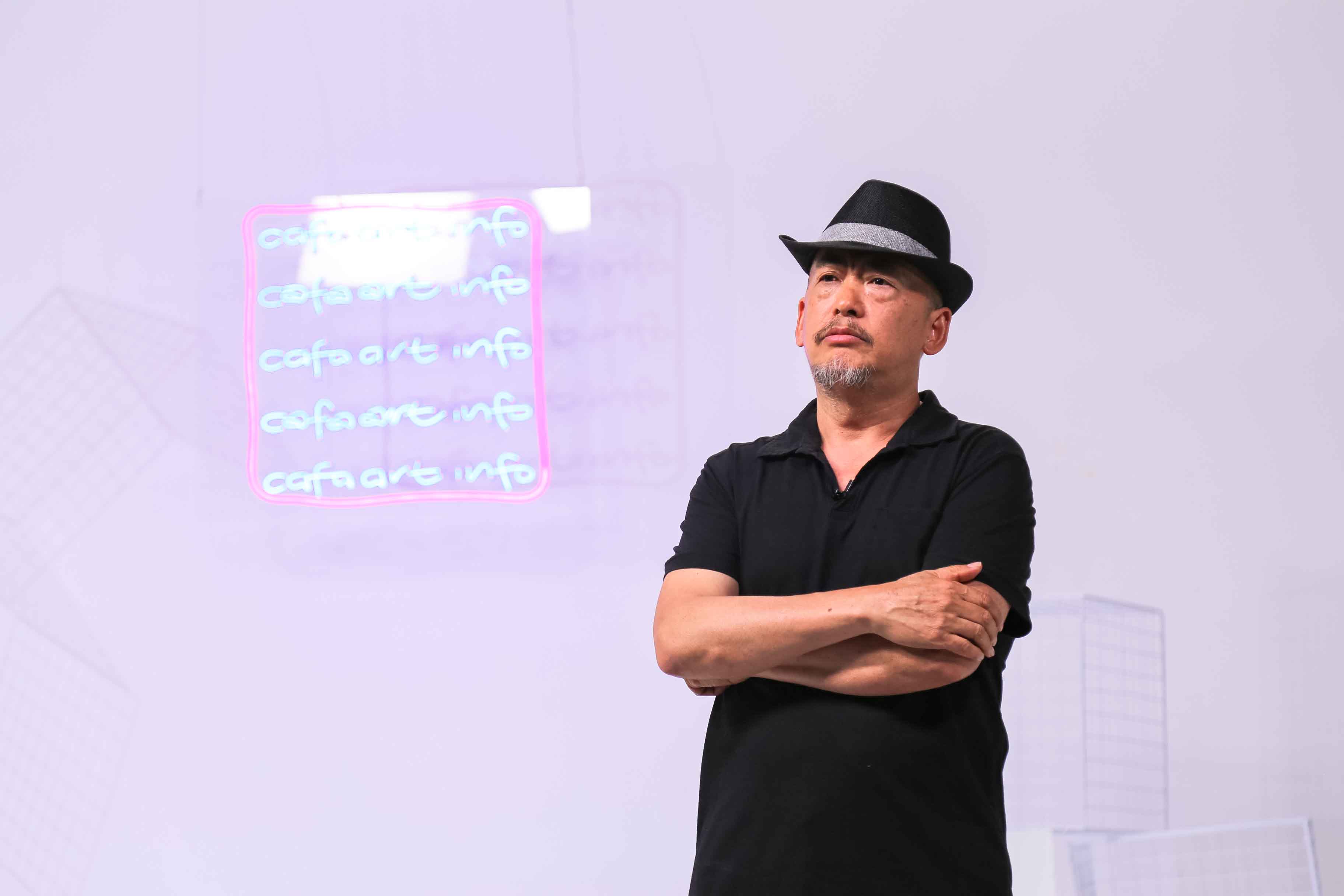
So, as an artist or a painter, the most important thing is from what perspective and at what distance you look at the world—it’s different when you look at a person at a distance of 10 centimeters from that of 1 centimeter; it’s also different when you have no distance from your closest one, and when you stay away from the one you hate, right? You must feel uncomfortable even at a short distance from the boring ones, and you may feel sick even hearing their names. What does it indicate? Our perception of the world is based on our own individuality and the world cannot be viewed from other peoples’ perspective. However, the current values and the whole trend are always viewed from the perspective of art history. It’s true that we have to go from a global perspective, but this angle can’t replace the personal point of view. So by talking about the vertical height, I mean anything with only width but without height won’t stay. Money, time as well as efforts spent on them will determine that it is in vain; life in this pursuit will finally be wasted.




